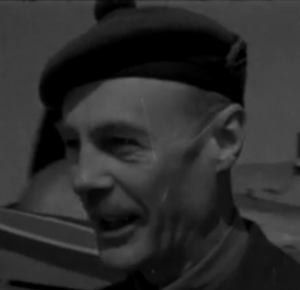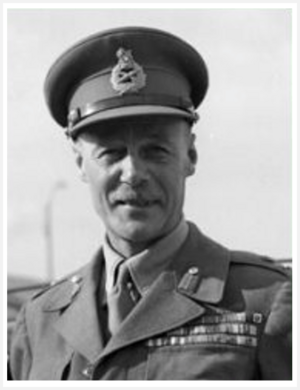Gordon MacMillan facts for kids
Quick facts for kids
Sir Gordon MacMillan
|
|
|---|---|

General Sir Gordon MacMillan – portrait by Leonard Boden, Argyll and Sutherland Highlanders Museum, Stirling Castle.
|
|
| Nickname(s) | "Babe" |
| Born | 7 January 1897 Bangalore, Kingdom of Mysore, India |
| Died | 21 January 1986 (aged 89) Renfrewshire, Scotland |
| Buried |
Newington Cemetery, Edinburgh, Scotland
|
| Allegiance | United Kingdom |
| Service/ |
British Army |
| Years of service | 1915–1955 |
| Rank | General |
| Service number | 5880 |
| Unit | Argyll and Sutherland Highlanders |
| Commands held | Governor of Gibraltar Scottish Command British Forces in Palestine and Trans-Jordan 51st (Highland) Infantry Division 49th (West Riding) Infantry Division 15th (Scottish) Infantry Division 152nd Infantry Brigade 12th Infantry Brigade 199th Infantry Brigade |
| Battles/wars | First World War Anglo-Irish War Second World War Palestine Emergency |
| Awards | Knight Commander of the Order of the Bath Knight Commander of the Royal Victorian Order Commander of the British Empire Distinguished Service Order Military Cross & Two Bars Mentioned in Despatches (2) Grand Officer of the Order of Orange-Nassau (Netherlands) |
| Relations | Sir John MacMillan (son) |
General Sir Gordon Holmes Alexander MacMillan of MacMillan and Knap (7 January 1897 – 21 January 1986) was a brave Scottish soldier. He became a high-ranking general in the British Army.
During the First World War, he showed amazing courage. He earned a special award called the Military Cross three times. At just 19 years old, he was already helping lead his battalion. Between the World Wars, MacMillan stayed in the army. He took on more important jobs. He married Marian Blakiston Houston in 1929. They had one daughter and four sons.
In the Second World War, MacMillan first helped defend England. He planned how to stop a possible German invasion. He then served in North Africa and Sicily. He led troops in important battles. Later, he commanded the 15th (Scottish) Infantry Division during the Battle of Normandy. He was wounded but returned to lead other divisions. These included the 49th (West Riding) Infantry Division and the 51st (Highland) Division.
After the war, MacMillan worked on army weapons. He then led British forces in Palestine. This was a very difficult time. His last army job was as Governor of Gibraltar. He retired in 1955. Gordon MacMillan was also the traditional Chief of the Clan MacMillan. After leaving the army, he spent his time helping Scottish life and society.
Contents
Early Life and First World War Heroics
Gordon Holmes Alexander MacMillan was born in Bangalore, India, on 7 January 1897. His father owned a coffee farm. When Gordon was three, his Scottish parents moved back to Britain. They wanted to raise their only son there.
At age ten, he went to St Edmund's School, Canterbury. In April 1915, he won a special scholarship. This allowed him to attend the Royal Military College, Sandhurst. This was a military training school. He joined the army during the First World War.
On 11 August 1915, MacMillan became a second lieutenant. He joined the Argyll and Sutherland Highlanders regiment. He was not yet 19, so he first went to a training unit. In April 1916, he went to the Western Front in France. He joined the 2nd Battalion. They were fighting in fierce trench warfare.
He fought in major battles like the Battle of the Somme and First Battle of Passchendaele. At just 19, he became the acting adjutant (a key administrative officer) of his battalion. He was promoted to lieutenant in April 1917. He stayed as adjutant for the rest of the war. He worked with seven different commanding officers. The fighting was very dangerous. At one point, he even found himself commanding the entire battalion.
MacMillan was one of only 168 soldiers to receive the Military Cross (MC) and two Bars in the First World War. This means he earned the MC three times. His awards were for his amazing bravery. He showed courage in battles at High Wood (July 1916), Arras (April 1917), and Le Cateau (October 1918).
Between the World Wars
After the war, MacMillan decided to stay in the army. He continued as his battalion's adjutant until December 1920. At that time, his battalion was in Ireland. He was promoted to captain in August 1924. He sometimes served as a company commander.
From 1928 to 1929, he attended the Staff College, Camberley. This was a special school for future army leaders. Many of his classmates later became famous generals. On 10 August 1929, MacMillan married Marian Blakiston Houston. They had three children. He then worked in the War Office in London. He held various staff roles.
In 1934, he briefly commanded the Guard for the Royal Family at Balmoral Castle. In 1935, he became an instructor at the Royal Military College of Canada. He taught there for two years. He returned to the War Office in 1937. He was promoted to major in August 1938. By January 1939, he was a staff officer at Eastern Command.
Second World War Leadership
When the Second World War began in September 1939, MacMillan was ready. In April 1940, he was promoted to acting lieutenant-colonel. He became a key staff officer for the 55th (West Lancashire) Infantry Division. This division was responsible for defending the British coast. They were preparing for a possible German invasion.
In May 1941, MacMillan was promoted to acting brigadier. He took command of the 199th Infantry Brigade. He trained his soldiers very hard. In December 1941, he became a senior staff officer for IX Corps. This corps was preparing for a big mission. This mission was the Allied invasion of French North Africa.
Fighting in North Africa and Sicily
In February 1943, IX Corps sailed to French North Africa. They joined the British First Army. They fought important battles against German troops. They helped capture Tunis in May 1943. This ended the Tunisian campaign. MacMillan was praised for his excellent service. He received the Commander of the Order of the British Empire (CBE) award.
After this, MacMillan was given command of the 152nd Infantry Brigade. This brigade was part of the famous 51st (Highland) Division. This division had fought bravely across North Africa. It was led by Major-General Douglas Wimberley. MacMillan's former instructor, General Bernard Montgomery, thought highly of him.
The 51st Division was chosen for the Allied invasion of Sicily. This was called Operation Husky. MacMillan led his brigade in the landings on 10 July. They faced tough German paratroopers. His brigade fought hard to capture the village of Francoforte. They suffered many casualties but succeeded. The campaign ended in August. MacMillan was awarded the Distinguished Service Order (DSO) for his leadership in Sicily.
Battles in Northwest Europe
After returning to the UK, MacMillan was promoted to acting major-general. He took command of the 15th (Scottish) Infantry Division. This division was preparing for Operation Overlord. This was the code name for the Allied invasion of Normandy. The division trained intensely in North Yorkshire.
The 15th Division landed in Normandy, France, on 13 June 1944. They arrived a week after D-Day. They prepared for a major offensive called Operation Epsom. MacMillan's division played a big role. They attacked German positions near Caen. His soldiers faced strong resistance. On 27 June, the 2nd Battalion, Argyll and Sutherland Highlanders, captured a key bridge. This created a "Scottish Corridor." The operation was very difficult. MacMillan's division suffered about 2,300 casualties.
After a short rest, the division fought in other operations. These included Operation Greenline and Operation Bluecoat. On 3 August, MacMillan was wounded in the knee by shrapnel. He had to be sent back to England. His corps commander, Lieutenant-General Richard O'Connor, praised him highly. He called MacMillan "the mainstay of this party." MacMillan received another award, the Companion of the Order of the Bath, for his efforts.

Once he recovered, MacMillan returned to Europe in November 1944. He became the commander of the 49th (West Riding) Infantry Division. This division was holding a key area near Nijmegen in the Netherlands. They faced German attacks during a very cold winter.
In March 1945, MacMillan was given command of the 51st (Highland) Division. This happened after his friend, Major-General Tom Rennie, was killed. MacMillan led the division after the important crossing of the Rhine river. His troops moved quickly into Germany. They fought many tough battles. The war in Europe ended on 8 May 1945. MacMillan led his troops in a victory parade. He received a Dutch award for his bravery in liberating the Netherlands. He was also mentioned in official reports twice for his distinguished service.
After the War and Retirement
After the war, MacMillan returned to the United Kingdom. He became the Director of Weapons and Development for the army. He was also made the Colonel of the Argyll and Sutherland Highlanders regiment.
In February 1947, he was appointed to lead British forces in Palestine. This was a very challenging job. The British government decided to end its control over Palestine. This led to more violence between Jewish and Arab groups. MacMillan's main goal was to safely remove all British troops and equipment. He faced assassination attempts. He was also criticized by both sides. On 30 June 1948, he was the last British soldier to leave Palestine.
In January 1949, MacMillan was knighted. He became a Knight Commander of the Order of the Bath. He was appointed to lead Scottish Command. He also became the Governor of Edinburgh Castle.
From 1952 until his retirement in 1955, he served as Governor of Gibraltar. This was a period of tension with Spain over Gibraltar. In 1954, Queen Elizabeth II visited Gibraltar. During her visit, she awarded MacMillan another knighthood. He became a Knight Commander of the Royal Victorian Order. On 1 January 1954, MacMillan was promoted to the rank of general.
After retiring from the army in 1955, MacMillan lived at Finlaystone House. This was his wife's family home in Scotland. He spent a lot of time improving the house and gardens. He also became very involved in Scottish life. He continued to support his old regiment. He even helped save it from being disbanded in 1968.
MacMillan was the hereditary Chief of the Clan MacMillan. He organized clan gatherings. He also served as chairman for several important organizations. These included the Greenock Harbour Trust and Erskine Hospital. He received an honorary law degree from the University of Glasgow in 1969.
Gordon MacMillan died in a car accident on 21 January 1986. He was 89 years old. He is buried in Newington Cemetery in Edinburgh.




